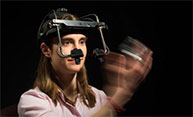
Andes mountains formed by ‘growth spurts’
Scientists have long been trying to understand how the Andes and other broad, high-elevation mountain ranges were formed. New research by Carmala Garzione, professor of earth and environmental sciences, provides an explanation.

Video gamers’ aggression linked to frustration, not violent content
The disturbing imagery of videos games are often accused of fostering feelings of aggression in players. But a new study shows hostile behavior is linked to gamers’ experiences of failure and frustration during play—not to a game’s violent content.

First 3-D image of structure below Sierra Negra volcano created
Home to some of the most active volcanoes in the world, researchers now have a better picture of the subterranean plumbing system that feeds the Galápagos volcanoes.

Women, minority judicial nominees receive lower ratings
A new study suggests that the American Bar Association ‘s sometimes-controversial ratings systematically award lower ratings to minorities and women than to white or male candidates.

How stellar death can lead to twin celestial jets
How do spherical stars evolve to produce highly aspherical planetary nebulae? A Rochester professor and his undergraduate student have a new theory as to why.

Sorry, cities: No strength in numbers
Urban legislators have long lamented that they do not get their fair share of bills passed in state governments, often blaming rural and suburban interests for blocking their efforts. Now a new study confirms one of those suspicions but surprisingly refutes the other.

Peeking into Schrödinger’s box
How do you measure a 27-dimensional quantum state, when the act of measuring can lead to its collapse? (photo by Flickr user Martin Cathrae)

Secret to Peanut-Shaped Star Orbits Peeled Away
Alice Quillen, professor of astronomy, and collaborators have created a mathematical model of what might be happening at the center of the Milky Way.

Depression Therapy Effective for Poor, Minority Moms
The study tested the effectiveness of interpersonal psychotherapy, a short-term depression treatment that has worked with more advantaged populations. The comparison was clear: home-based, interpersonal psychotherapy lifted depression much more effectively than standard care.

‘Seeing’ in the Dark
The eerie ability to see our hand in the dark suggests that the brain combines information from different senses to create perceptions.
